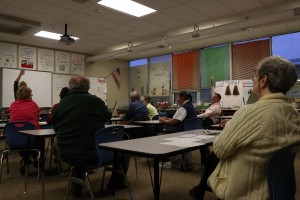By Ryan Joyner
Only 13 out of fewer than 200 registered voters attended section 109 of the Greater Salt Lake precinct during the Republican Caucuses held in March. This low number that was reflective of the majority of the precincts sections.
The small group was lead by Lari Kleinman who started off by reading GOP mission statement in the Salt Lake Center for Science Education charter school where the meeting was held, and closed after unanimously making appointments of group members to party positions.
The Great Salt Lake precinct is home to people in the majority ages 50’s and older a group, one that has largely been categorized as having the most active voters.

Experts point to social stability and the direct effect programs such as Social Security and Medicare have on the elderly as reasons for the uncommonly large turnout among the elderly — however, among recent years turn out among even this group has fallen drastically.
Kleinman said she remembers a time when her home was full and several people would vie for candidacy as a delegate.
Utah GOP party leader James Evans spoke about what needed to be done to improve precinct participation.
He and Kleinman talked about how moving caucus meetings to the local high school might have negatively impacted attendance because of the precincts geographic broadness and elderly’s inability to travel.
The meetings were originally moved because community members felt hosting a meeting within someone’s home gave unfair advantages to candidates who were friends of the host.
It remains to be seen is whether lower participation comes as the result of bills passed by Legislators moving races to a primary, failure to reach out, or a deeper mistrust that communities have of the political process.
Precinct Legislative Candidate Kris Smith said, “ it’s a sign of failing communities not a failing system.”




